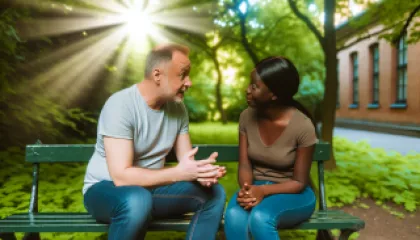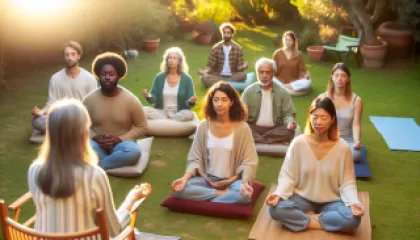Decoding Body Language: A Step-by-Step Guide
Decoding Body Language: A Step-by-Step Guide
In the dynamic world of interpersonal communication, body language plays a crucial role in shaping our perceptions, interactions, and overall effectiveness. Whether you're navigating a job interview, a business negotiation, or a social gathering, understanding and mastering the intricacies of body language can give you a distinct advantage. In this comprehensive guide, we'll delve into the fundamentals of body language, exploring a step-by-step approach to decoding and leveraging this powerful nonverbal communication tool.
Understanding the Importance of Body Language
Body language is the unspoken language that accompanies our verbal communication. It encompasses a vast array of physical cues, from subtle eye movements to expansive gestures, that convey our thoughts, emotions, and intentions. Studies have shown that nonverbal communication can account for up to 93% of the overall message we convey, with only 7% being attributed to the actual words we speak.
Mastering the art of body language analysis can provide you with a distinct advantage in a variety of contexts. By reading the subtle nuances of body language, you can gain valuable insights into the thoughts and feelings of those around you, allowing you to tailor your own communication style and responses accordingly. This heightened awareness can be particularly beneficial in high-stakes situations, such as job interviews, negotiations, or interpersonal conflict resolution, where the ability to read and respond to nonverbal cues can make all the difference.
The Fundamentals of Body Language
To effectively decode and utilize body language, it's essential to understand the underlying principles and the various elements that contribute to this nonverbal communication system. Let's explore the key components of body language and how they can inform our interactions.
Posture and Positioning
The way we hold our body and position ourselves in relation to others can convey a wealth of information. Upright, open posture often indicates confidence, engagement, and a willingness to interact, while hunched shoulders and crossed arms can suggest discomfort, defensiveness, or a desire to distance oneself. Similarly, the orientation of our body and the direction of our feet can provide insights into our level of interest or attention.
Facial Expressions
The human face is a veritable canvas of emotions, and the subtle movements and changes in our facial features can reveal a wealth of information. From a warm, genuine smile to a furrowed brow of concern, our facial expressions can communicate a range of feelings and reactions, often before we even utter a word.
Eye Contact and Gaze
The eyes are often referred to as the windows to the soul, and for good reason. The way we make and maintain eye contact, as well as the direction of our gaze, can convey a wealth of information about our level of engagement, interest, and emotional state. Prolonged eye contact can indicate confidence and a desire to connect, while averted eyes may suggest discomfort, dishonesty, or a lack of interest.
Gestures and Movements
Our hands, arms, and overall body movements play a significant role in nonverbal communication. Gestures can be used to emphasize or complement our verbal messages, while specific movements, such as fidgeting or restless shifting, can reveal underlying feelings of nervousness, boredom, or impatience.
Vocal Cues
While not strictly considered "body language," the tone, volume, and cadence of our voice can also contribute to the overall nonverbal message we convey. Changes in vocal patterns, such as a higher pitch or a quivering voice, can indicate emotions like excitement, stress, or uncertainty.
Developing a Keen Eye for Body Language
Becoming proficient in reading and interpreting body language is a skill that requires practice and a keen observational eye. Here are some steps you can take to hone your body language analysis skills:
Observe and Analyze
Start by actively observing the body language of those around you in various settings. Pay attention to the subtle cues and patterns that emerge, and try to identify the underlying emotions or intentions behind the nonverbal signals. As you become more attuned to these nuances, you'll start to recognize common patterns and gain a deeper understanding of how body language operates.
Practice Self-Awareness
Becoming more aware of your own body language is an essential step in mastering this skill. Take note of how your posture, facial expressions, and gestures change in different situations and emotional states. By understanding your own nonverbal communication, you'll be better equipped to interpret the body language of others.
Seek Feedback and Validation
Engage with others and seek their feedback on your body language interpretations. Ask trusted friends, colleagues, or mentors to provide insights into how your own nonverbal cues are perceived, and be open to constructive criticism. This feedback can help you refine your skills and identify areas for improvement.
Adapt and Adjust
As you continue to hone your body language analysis skills, be prepared to adapt and adjust your approach. Different cultural contexts, individual preferences, and situational factors can all influence the interpretation of nonverbal cues. Remain flexible and open-minded, and be willing to reevaluate your assumptions as you encounter new situations and interactions.
Applying Body Language Strategies in Different Contexts
The ability to read and utilize body language effectively can be invaluable in a variety of professional and personal settings. Let's explore how you can apply these skills in some common scenarios:
Job Interviews
During a job interview, pay close attention to the interviewer's body language to gauge their level of interest and engagement. A warm, open posture and frequent eye contact may indicate a positive impression, while crossed arms or fidgeting could suggest discomfort or skepticism. Likewise, be mindful of your own body language, ensuring that you project confidence, enthusiasm, and a genuine interest in the role.
Business Negotiations
In the high-stakes world of business negotiations, the ability to read and respond to body language can give you a significant advantage. Observe your counterpart's posture, gestures, and facial expressions to gauge their level of comfort, confidence, and receptiveness to your proposals. Additionally, be conscious of your own nonverbal cues, ensuring that they align with your negotiation strategy and convey a sense of authority and trustworthiness.
Interpersonal Relationships
Body language plays a crucial role in the development and maintenance of interpersonal relationships. Pay attention to the nonverbal signals exchanged during social interactions, as they can provide insight into the level of comfort, attraction, or tension between individuals. By understanding and responding appropriately to these cues, you can foster stronger connections, navigate difficult conversations, and build more meaningful relationships.
Public Speaking and Presentations
When delivering a speech or presentation, your body language can have a significant impact on the audience's perception and engagement. Maintain an open, confident posture, make frequent eye contact, and use purposeful gestures to emphasize your key points. Avoid fidgeting or other distracting movements, as they can undermine the effectiveness of your message and undermine your credibility.
Mastering the Art of Body Language
Decoding and effectively utilizing body language is a skill that requires ongoing practice and refinement. By developing a keen eye for nonverbal cues, cultivating self-awareness, and applying these strategies in various contexts, you can unlock a powerful tool for enhancing your communication, building stronger relationships, and achieving your personal and professional goals.
Remember, body language is a complex and nuanced form of communication, and the interpretation of nonverbal cues can vary across cultures and individual preferences. Approach this topic with an open and adaptable mindset, and be willing to continuously learn and refine your skills. With dedication and practice, you can become a master of body language, empowering you to navigate the social landscape with confidence and success.
Conclusion
In the ever-evolving world of communication, the mastery of body language is a skill that can set you apart and propel you towards greater personal and professional success. By understanding the fundamentals of nonverbal communication, developing a keen observational eye, and applying these strategies across diverse contexts, you can unlock a powerful tool for enhancing your interactions, building stronger relationships, and achieving your goals.
Remember, the journey of decoding body language is an ongoing one, filled with opportunities for growth and discovery. Embrace the challenge, stay curious, and always be willing to adapt and refine your approach. With time and practice, you'll become a true master of this subtle yet powerful form of communication, empowering you to navigate the social landscape with confidence and grace.






